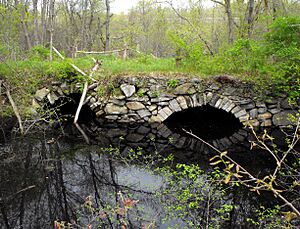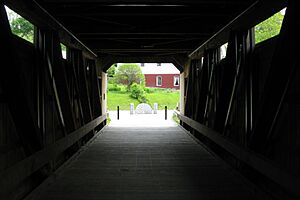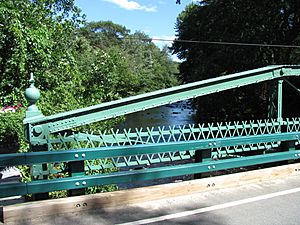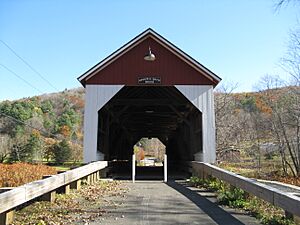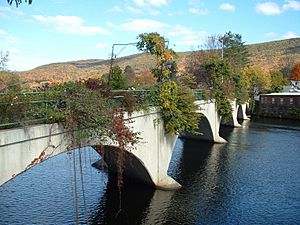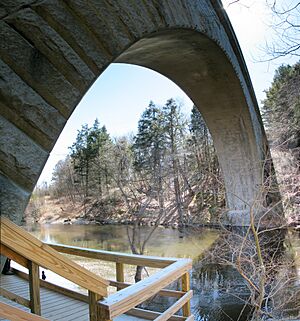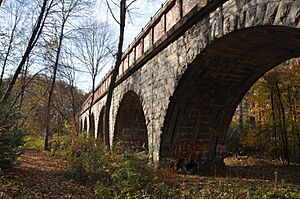List of bridges on the National Register of Historic Places in Massachusetts facts for kids
This article is about some really cool old bridges and tunnels in Massachusetts that are listed on something called the National Register of Historic Places. These special places are recognized for their history and how important they are to our country's story.
Contents
Amazing Historic Bridges in Massachusetts
Massachusetts is home to many amazing old bridges and tunnels. These structures aren't just ways to get from one place to another; they are also important parts of history. They show us how people built things long ago and how transportation has changed over time.
What is the National Register of Historic Places?
The National Register of Historic Places is like a special list of buildings, sites, structures, objects, and districts that are important in American history, architecture, archaeology, engineering, or culture. When a bridge or tunnel is added to this list, it means it's recognized as a valuable piece of our past that should be protected and remembered. It helps people appreciate and learn about these historic treasures.
Bridges with Cool History
Let's explore some of these fascinating bridges and tunnels in Massachusetts. Each one has its own story and unique features!
The Oldest Bridges
Some bridges in Massachusetts have been around for a very long time! They've seen many years of history pass by.
The Choate Bridge in Ipswich is one of the oldest. It was built way back in 1764! This bridge is a double stone arch, which means it has two rounded openings made of stone. It's known as the oldest bridge of its kind in the entire country. Imagine all the people and carriages that have crossed it over the centuries!
Another very old one is the Canton Viaduct in Canton, built in 1834. A viaduct is a long bridge-like structure that carries a road or railway over a valley or other obstacle. This one is a historic railroad bridge.
The Double-arch Sandstone Bridge in Methuen was built in 1835. It's special because it's a "mortarless twin arch," meaning the stones are fitted together so perfectly that they don't need mortar (a type of cement) to hold them in place. That's some clever engineering!
Unique Bridge Designs
Many of these historic bridges have interesting designs that were cutting-edge for their time.
The Burkeville Covered Bridge in Conway was built in 1870-1871. It's a "multiple kingrod truss" bridge, and it's covered, which means it has a roof and sides. Covered bridges were often built to protect the wooden parts of the bridge from weather, making them last longer.
The Crossman Bridge in Warren, built in 1888, is one of the few remaining "lenticular pony truss bridges" in Massachusetts. "Lenticular" means it has a lens shape, curving both above and below the bridge deck. It's a very distinctive look!
The Arthur A. Smith Covered Bridge in Colrain, built around 1868-1896, uses a "Burr arch truss system." This system combines a strong arch with a truss (a framework of connected beams) to make the bridge very sturdy.
Bridges with Special Stories
Some bridges have become famous for reasons beyond just their structure.
The Bridge of Flowers in Shelburne and Buckland is truly unique. Built in 1905, it was originally a trolley bridge. But after the trolley line closed, it was transformed into a beautiful pedestrian bridge covered in flowers and plants! It's a wonderful example of how old structures can be given new life.
The Echo Bridge in Needham and Newton, built in 1876-1877, is part of the historic Sudbury Aqueduct system, which brought water to Boston. It's called "Echo Bridge" because if you stand in the right spot underneath, you can hear your voice echo many times!
The Waban Arches Bridge in Wellesley, built in 1875, is also part of the Sudbury Aqueduct. This bridge carries the aqueduct, which is like a giant water pipe, over Waban Brook. It's a great example of how engineers built systems to bring clean water to cities long ago.
Why are These Bridges Important?
These historic bridges and tunnels are more than just old structures. They are important because:
- They show us how people used to build things and the amazing engineering skills they had without modern tools.
- They tell us about the history of transportation and how people and goods moved around Massachusetts.
- They are often beautiful landmarks that add character to their towns and cities.
- By preserving them, we keep a piece of our past alive for future generations to learn from and enjoy.
So, the next time you cross a bridge, take a moment to think about its history and the stories it could tell!
Images for kids



